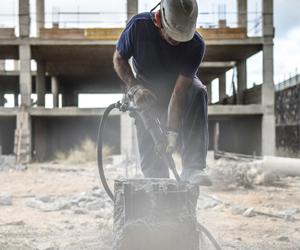What is crystalline silica?
Silica is silicon dioxide, a naturally occurring and widely abundant mineral that forms the major component of most rocks and soils. There are non-crystalline and crystalline forms of silicon dioxide.
The crystalline form is found in multiple building materials such as bricks, tiles, concrete, engineered and natural stone products, sandstone, and fibre cement sheeting. It can be a health hazard when it turns into dust.
What is silica dust?
Silica dust is generated in workplace mechanical processes such as crushing, cutting, drilling, grinding, sawing or polishing materials containing crystalline silica.
Some dust particles are so small that they are not visible. These are commonly called respirable particles. Silica dust is more than 15 times smaller than a piece of human hair. Respirable silica dust particles are small enough to penetrate deep into the lungs, and can cause irreversible lung damage. (The non-crystalline or amorphous forms of silica do not cause this kind of lung damage.)
What diseases can silica dust cause?
Although respirable crystalline silica is an A1 carcinogen and the respiratory issues related to silica dust have been recognised for over a century, occupational lung disease has only come to the forefront of Australian safety management recently, after a surge in diagnosed cases of silicosis.
There are a number of forms of silicosis, depending on how much dust workers have been exposed to and over what period of time:
- acute silicosis, which can develop after a short exposure to very high levels of silica dust, within a few weeks or years, and causes severe inflammation and an outpouring of protein into the lung
- accelerated silicosis, which can develop after exposures of 3 to 10 years to moderate to high levels of silica dust and causes inflammation, protein in the lung and scarring of the lung (fibrotic nodules)
- chronic silicosis, which can develop after long term exposure to lower levels of silica dust and causes fibrotic nodules and shortness of breath, and can include progressive massive fibrosis where the fibrotic nodules in the lung aggregate.
Workers exposed to silica dust may also develop other diseases including:
- chronic bronchitis
- emphysema
- lung cancer
- kidney damage
- scleroderma (a disease of the connective tissue of the body that causes scar tissue to form in skin, joints and other organs).
Silica in the workplace: your responsibilities
Under the WHS regulations, persons conducting a business or undertaking (PCBUs) have specific duties to manage the risks to health and safety when using, handling, generating and storing hazardous chemicals, including silica.
The workplace exposure standard for respirable crystalline silica is that it must not exceed 0.05 mg/m3 (eight hour time weighted average).
How Can Airsafe Help
Hazard Identification
Airsafe can test material using a NATA accredited laboratory and provide a risk assessment based on the findings.
Workplace Monitoring
Airsafe is accredited by NATA for volume measurement. All filters are analysed by a NATA accredited facility.
All Airsafe test reports have metrological traceability, and all work is completed in accordance with the relevant Australian Standard.




